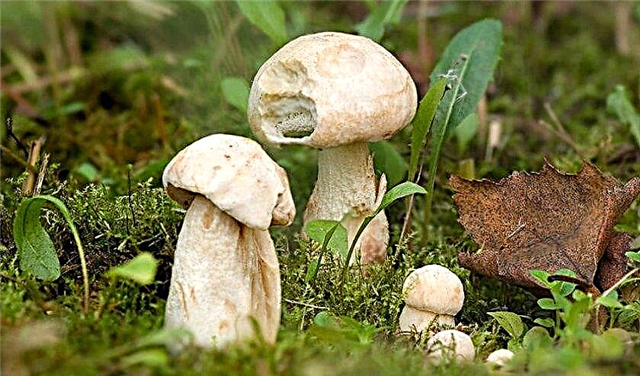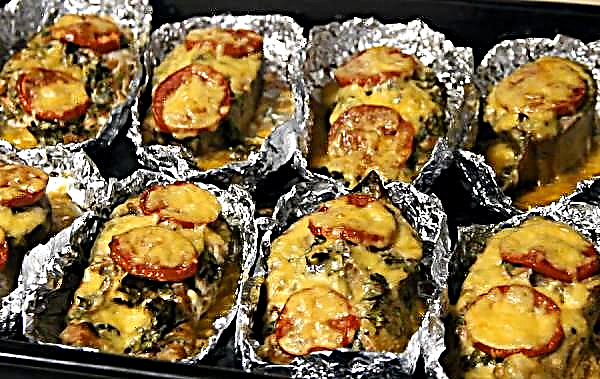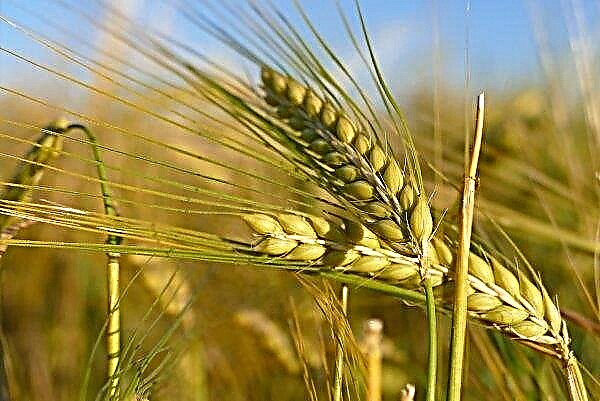During breastfeeding, the mother's diet should be aimed at maintaining her own health and the health of the baby. One of the best sources of natural protein, many vitamins and mineral components is hazelnut. However, this type of nuts is characterized by increased allergenicity and can cause adverse reactions of the body. Are nursing mothers allowed to consume hazel, and in what form it is better to use it so as not to harm the baby - further in the article.
Can hazelnuts be breastfed
To the question: "Is it allowed to consume hazelnuts when you are feeding a baby?" There is no single answer, because everything will depend on the individual characteristics of the woman’s body and the condition of the baby. Of course, this type of nuts is characterized by high nutritional value, it contains a large amount of protein, fats, essential acids, active biological components that contribute to the normal development of the baby, strengthen its immune system, normalize the functioning of all systems of the child’s body.
In addition, the consumption of the described product increases the fat content of mother’s milk, stimulates the lactation process, helps a woman to get into prenatal form faster. Meanwhile, hazelnuts are the second nut after peanuts, which can cause allergic reactions. Therefore, when using, you should adhere to certain rules and dosages.
Due to the high risk of allergies, it is strictly forbidden for nursing mothers to eat hazelnuts in the first 3-4 weeks after birth. Next, the product should be administered carefully, in small portions, carefully monitoring the reaction of the baby. In the absence of negative reactions from the baby, it is allowed to increase the daily dosage.
Important! Before introducing hazelnuts into the diet, it is imperative to consult a doctor.
Beneficial features
Hazelnuts - a delicious, nutritious and very healthy nut that has a balanced, multi-component chemical composition represented by vitamins C, A, E and group B, minerals - calcium, potassium, phosphorus, magnesium, zinc, iron, organic acids, fats, essential oils, tannins, vegetable protein. Such a complex of valuable substances determines the useful qualities of the product.
- Regular consumption of hazelnuts allows you to:
- strengthen the immune system, protect the body of mother and child from viruses and infections;
- accelerate metabolic processes, improve metabolism, thereby quickly restore the body after childbirth and lose excess kilograms gained during pregnancy;
- prevent stagnation of milk in the glands, thereby becoming a prevention of mastitis;
- stimulate milk production;
- increase the nutritional value and fat content of the dairy product;
- restore strength, improve mood, prevent the appearance of depression and depression;
- improve the condition of hair, skin and nails;
- cleanse the body of toxins and harmful substances, fight the negative effects of free radicals;
- have a beneficial effect on the functioning of the cardiovascular and nervous systems;
- ensure the full and proper development of the child.
Did you know? Surprisingly, there is even a Hazelnut Institute in the world, which is located in the city of Trabzon, in Turkey. The location of such an institution is quite logical, because the Republic of Turkey is the world leader in the cultivation of hazel.
Contraindications
Despite the wide range of useful properties of hazel fruits, if used uncontrolled, they can harm the health of the mother and child, cause certain health problems.
In particular:
- Calorie content. Walnut is a high-calorie product with 704 kcal per 100 g of raw materials. That is why the consumption of hazelnuts in large quantities can provoke weight gain in the mother and the appearance of various problems with the digestive tract in the baby - colic, constipation or diarrhea, bloating.
- Allergenicity. As already noted, hazel is considered one of the most allergenic foods. Walnuts, almonds are more "safe", so doctors advise to enter them in the diet first. Consumption of hazelnuts often causes itching, rash, runny nose, digestive upset, and sometimes vomiting and coughing in infants.

If there is at least one negative symptom, you should immediately stop eating nuts and consult an allergist. Usually, the symptoms of food allergies disappear in the baby 2-3 weeks after the exclusion of the product from the mother’s diet. But if the child has strong immunity and the dose of the allergen was small, then the negative manifestations may disappear on 3-5 days.
The norm of eating nuts to a nursing mother
So that when breastfeeding, the mother and the baby do not have health problems, the use of hazelnuts should be dosed. First of all, remember that eating nuts in the first month after childbirth is prohibited. Next, you need to introduce the product gradually, gradually increasing the daily portion.
Important! If the child has a genetic predisposition to allergies, then the consumption of hazel should be postponed until the baby is 6 months old.
At first, it is enough to eat no more than one nut kernel per day, gradually bringing the portion to 8 fruits (maximum). The most important thing when consuming a product is to stick to the measure. Along with the introduction of hazelnuts in the diet, it is recommended to carefully monitor the condition of the child's body. If any unnatural reactions appear - rashes, itching, vomiting, diarrhea, increased gas formation, you must immediately stop eating nuts.
A month later, when the symptoms of allergy disappear, it is allowed to try again to introduce nuts into the diet. The maximum daily dosage of hazelnuts for a one-month-old mother is 15–20 g or 2–3 fetuses, for a three-month mother –– 20–25 g or 5–7 kernels, and five –– and six – month –– 6–8 or 25–30 g.

Rules for the use of hazelnuts in lactation
Observance of certain rules for eating hazelnuts during a period when a mother feeds her baby with breast milk will allow both her and her child to avoid many health problems.
- During lactation, experts, first of all, advise starting to introduce safer and less allergenic nuts - almonds, walnuts, cedar nuts, into the diet. In the first month after birth, it is better to refrain from eating hazel.
- You need to buy only whole, inshell nuts, and peeled nuts should be stored in a tightly closed container, away from direct sunlight.
- Before you eat hazelnuts, you should carefully examine it for mold, black spots, and manifestations of the fungus. Even a slightly bitter unpleasant taste suggests that the fruit is affected by mold or spores of toxic microorganisms. Such nuts are strictly prohibited during lactation.
- When breastfeeding, it is forbidden to consume several varieties of nuts at the same time.
- It is better to eat hazelnuts in the morning, so that until the evening to monitor the condition of the baby and take the necessary therapeutic measures (if necessary) until nightfall.
Did you know? There are about 20 types of hazelnuts, but the most famous are three: badem, kerasund and Crimean. They differ only in appearance, but are exactly the same in quality.
Hazelnut Recipes
A varied, healthy and balanced menu for a nursing mother is the key to her good mood and well-being. In order to diversify the diet, hazelnut is recommended to be used not only in a “pure” form, but also to make it the basis of interesting dishes, including desserts or salads.
Hazelnut candies
Sweets are for many women one of the favorite desserts, without which it is difficult to imagine your life. Nursing mothers have the opportunity not to give up treats and prepare it from healthy hazel.

To make sweets, you will need the following ingredients:
- hazel: 8-10 cores;
- prunes: 50 g;
- dried apricots: 50 g;
- raisins (from light grape varieties): 30 g.
The step-by-step preparation of a nut treat is reduced to the following steps:
- Rinse dried fruits, soak in warm water for 60 minutes.
- Dry the products on a napkin, pass through a meat grinder.
- Grind half the nuts.
- From a dried fruit to make a ball in the middle of which place a whole hazelnut.
- Roll the resulting candy in chopped nuts.
 It is recommended to eat no more than 5 pieces per day.
It is recommended to eat no more than 5 pieces per day.
Fruit and hazelnut salad
To prepare a fruit dessert, you need to prepare:
- hazel: 2 tbsp. l shredded fruits;
- green apples: 400 g;
- plum: 400 g;
- lemon juice: ½ lemon;
- honey: 2 tbsp. l
A delicious and fragrant dessert is prepared as follows:
- Peel the apples and grate on a medium grater.
- Rinse the plums, cut into two halves, add to apples.
- Pour apple-plum mix with lemon juice and season with honey.
- Sprinkle fruit salad on top with chopped nuts.

Banana cookies with hazel
Conventional cookies in milk and butter for babies can be "difficult" for its weak digestive system.
Therefore, experts advise you to prepare a “light” treat, for which you will need:
- hazelnuts: 2 tbsp. (crushed);
- banana: 2 pcs.;
- oatmeal: 1 cup;
- raisins (from light grape varieties): 2 tbsp. l .;
- granulated sugar: 2 tbsp. l
We recommend that you find out how cherry, raspberry, and apricot affect the body when breastfeeding.
Cooking baked goods can be easy if you follow the instructions:
- Grind bananas until smoothie, add sugar and oatmeal. Mix.
- To the resulting mass add hazelnuts and raisins.
- From the dough to form shapes of arbitrary shape, put them on parchment paper, pre-greased with butter.
- Bake for 20-30 minutes.
 Cookies are dietary and very “light.” Instead of raisins, it is allowed to add a few pieces of dark chocolate to the dough.
Cookies are dietary and very “light.” Instead of raisins, it is allowed to add a few pieces of dark chocolate to the dough.
Hazelnuts are one of the most delicious and nutritious foods, which, in the absence of contraindications, is recommended to be included in the diet of a nursing mother. Walnut allows you to strengthen the baby’s immunity, improve the quality and nutrition of breast milk, and help a woman recover faster after giving birth. However, it must be remembered that the product is allergenic and its use should be strictly dosed.












